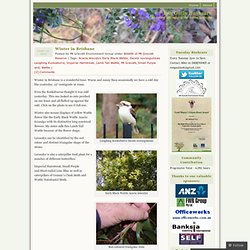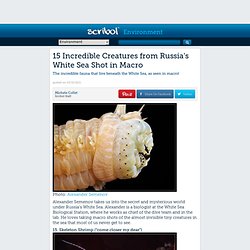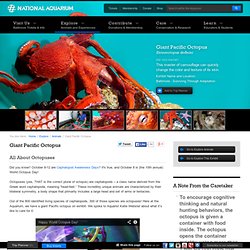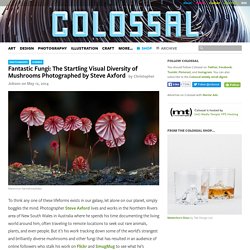

The Cutest Creatures Under The Sea - Dude It's News! Okapi. Fox Gully Bushcare. June 12, 2011 Winter in Brisbane is a wonderful time.

Warm and sunny then occasionally we have a cold day like yesterday, 13° centigrade at 10am. Laughing Kookaburra Dacelo novaeguineae Even the Kookaburras thought it was cold yesterday. This one looked so cute perched on our fence and all fluffed up against the cold. Early Black Wattle Acacia leiocalyx Winter also means displays of yellow Wattle flower like the Early Black Wattle Acacia leiocalyx with its distinctive long cynctrical flowers. Red coloured triangular stem Leiocalyx can be identified by the red colour and distinct triangular shape of the stems. Leiocalyz is also a caterpillar food plant for a number of different butterflies: Wattle Notodontid Moth Neola semiaurata Imperial Hairstreak, Small Purple and Short-tailed Line Blue as well as caterpillars of Granny’s Cloak Moth and Wattle Notodontid Moth.
October 28, 2010 Discover monsters in the bush Wattle Notodontid Moth or Monster – click if you dare … the stuff of nightmares. Mike. Wattle Notodontid Moth - Neola semiaurata. This page contains pictures and information about Wattle Notodontid Moths and caterpillars that we found in the Brisbane area, Queensland, Australia.

Length 40mm This Caterpillar will raise its head and/or tail when disturbed. It will also display the eye-spots on its tail. The caterpillar is colourful and actively feeding during the day. They feed on leaves of different species of wattle Acacia. We found this caterpillar feeding on wattle leaves in Karawatha Forest during late summer. As other caterpillars in the family Notodontidiae, when disturbed, the caterpillar raised its head. The caterpillar is common in Brisbane bushlands. They pupate in cocoon on ground under plant materials. 36 Perfectly Timed Animal Shots. The Cutest Creatures Under The Sea - Dude It's News! 15 Incredible Creatures from Russia's White Sea Shot in Macro.
Photo: Alexander Semenov Alexander Semenov takes us into the secret and mysterious world under Russia’s White Sea.

Alexander is a biologist at the White Sea Biological Station, where he works as chief of the dive team and in the lab. He loves taking macro shots of the almost invisible tiny creatures in the sea that most of us never get to see. 15. Skeleton Shrimp (“come closer my dear”) Photo: Alexander Semenov This little horror may be a very common shrimp in the White Sea but he sure doesn’t look friendly! 14. Photo: Alexander Semenov This beautiful brachiopod is a living fossil. 13. Photo: Alexander Semenov Nerei Pellagica is also known as the sandworm and is huge. 12. Photo: Alexander Semenov This monstrous face is nasty!
11. Giant Pacific Octopus. All About Octopuses Did you know?

October 8-12 are Cephalopod Awareness Days? It's true, and October 8 is (the 10th annual) World Octopus Day! Octopuses (yes, THAT is the correct plural of octopus) are cephalopods – a class name derived from the Greek word cephalopoda, meaning “head-feet.” These incredibly unique animals are characterized by their bilateral symmetry, a body shape that primarily includes a large head and set of arms or tentacles. Out of the 800 identified living species of cephalopods, 300 of those species are octopuses! Octopus Infographic Click for full infographic Octopuses are mollusks, related to squid, clams, and snails. Like squid, they are cephalopods, meaning ‘head-foot’, so named because the feet (arms) are attached to the head.
The bulbous sack-like body, or mantle, is perched atop the head; the mouth and beak are on the underside, where the arms converge. Octopuses have a highly developed brain and acute vision. Diet. Fantastic Fungi: The Startling Visual Diversity of Mushrooms Photographed by Steve Axford. Marasmius haematocephalus To think any one of these lifeforms exists in our galaxy, let alone on our planet, simply boggles the mind.

Photographer Steve Axford lives and works in the Northern Rivers area of New South Wales in Australia where he spends his time documenting the living world around him, often traveling to remote locations to seek out rare animals, plants, and even people. But it’s his work tracking down some of the world’s strangest and brilliantly diverse mushrooms and other fungi that has resulted in an audience of online followers who stalk his work on Flickr and SmugMug to see what he’s captured next.
Axford shares via email that most of the mushrooms seen here were photographed around his home and are sub-tropical fungi, but many were also taken in Victoria and Tasmania and are classified as temperate fungi. The temperate fungi are well-known and documented, but the tropical species are much less known and some may have never been photographed before.
Panus fasciatus.